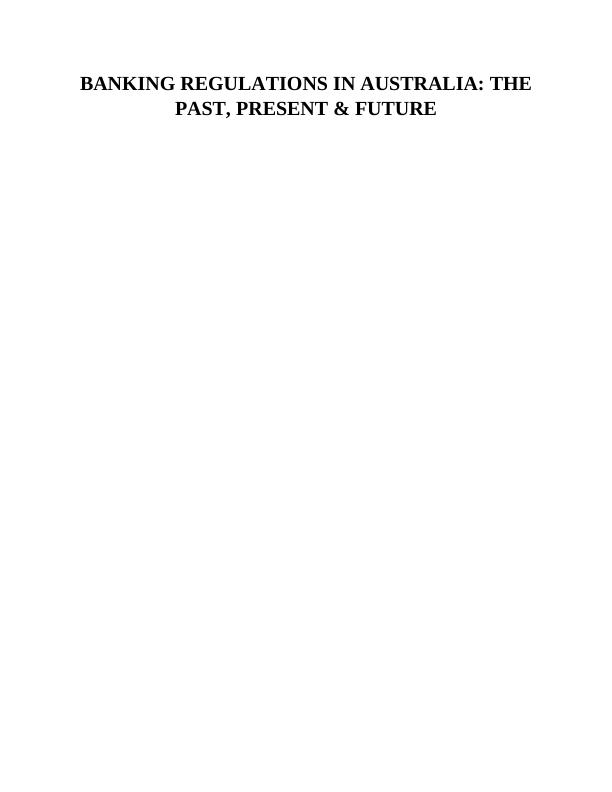Banking Regulations in Australia: Report
Added on 2020-03-23
9 Pages3198 Words98 Views
BANKING REGULATIONS IN AUSTRALIA: THEPAST, PRESENT & FUTURE

The financial system of Australia has experienced instrumental change since itsinception. Though the difference between the different forms of financial institutions has blurredwith time, the structure of this system is usually typified in context of the primary institutionswhich operate within it. Based on this, four major developments in the financial system structureof Australia stand out. The first and foremost is the rise in significance of banks, which directlymake up for half of the assets of the overall financial system today, up from 40% in 1985.Besides the conventional lending and retail deposit taking functions, banks are engaged in almostevery facet of financial intermediation, such as fund management, insurance, stockbroking,financial markets and business banking. Currently, there are 53 banks in the country, out ofwhich 14 are Australia owned. The four biggest banks within the banking system of the nationare Westpac Banking Corporation, Commonwealth Bank of Australia, National Australia Bank,and ANZ Banking Group (Goodhart et al., 2013). The present essay delves into the history,present and future of banking regulation in Australia. In 1911, the Commonwealth Bank of Australia was set up through an Act. Thisinstitution was later on renamed as Reserve Bank of Australia in 1959 under the law, todischarge central banking functions. The commercial and savings functions were moved to aseparate body corporate, that held the original name of Commonwealth Bank of Australia. Thepower to formulate laws regarding banking and currency was then vested with the AustralianParliament after the Federation of the Australian States into the Commonwealth of Australia.During 1911, the Bank was given the responsibility of the regular functions of savings andcommercial banking under the initial Commonwealth Bank Act (Paterson and Mallesons, 2017).It did not hold central banking remit, nor was it in charge of issuing notes. The Governor had themanagement of the Bank under his authority. The Bank commenced business during mid-1912.The Treasury Department was administering note issue at that time. The duty of issuing notes was given to a Notes Board in 1920, from the Treasury. Thisboard comprised of four people who were assigned by the Government. By virtue of his position,the Governor of the Bank was also a member of the Notes Board. Note issue was resultantlyadministered by the Bank, although the two bodies were independent of one another. Afteramendments in the Commonwealth Bank Act 1924, the control of issuing notes was transferredto the Bank. Board, comprising of 8 directors, was given the administration of this (Black,Kirkwood and Shah, 2009). Since then till 1945, the central banking functions of the Bank

evolved steadily, principally to counter the demands of the financial crisis during the 1930s andsubsequently by formal extension of its authority under wartime legislations. These encompassedexchange control plus a plethora of other controls over the system. The reformed CommonwealthBank Act in conjunction with the Banking Act, both created during 1945, made the Bank’spowers pertaining to the overseeing of banking and fiscal policy and forex control official. Theboard ceased in existence as per the legislation of 1945 and in its place, came an advisory councilwhich had 6 members (officials from the Treasury and Bank). The legislation clearly mentionedthat the Governor would still be accountable for Bank’s management (McCoach and Landy,2013). Nonetheless, a new Act in 1951, created a new board which comprised ten members andthe Governor was still responsible for management of the Bank. This has long been the structureof the board since then, barring a few modifications. As aforementioned, the Reserve Bank Act of 1959 conserved the initial body corporate,under the name of RBA, to undertake the central functions of banking of the CommonwealthBank, which had developed gradually; other Acts differentiated the savings banking andcommercial banking activities into the new formed Commonwealth Banking Corporation. TheReserve Bank Act of 1959 became enforceable from January 14th, 1960 (Wallison, 2013). Therewere not many significant modifications in the activities of the RBA until the removal ofexchange control subsequent the float of the country’s currency in 1983. However, there weresome gradual shift toward market-centric techniques of executing monetary policy, a movementfrom the system of direct controls on the country’s banks. The Campbell Committee, animportant financial system inquiry was formed in 1979, and five years after its appointment, thefinancial scenario of Australia changed to a virtually deregulated system. During the same time,the RBA developed a specialized banking supervisory function (Putnis, 2014). One more inquiry (the Wallis Committee) was announced into the Australian Financialsystem in 1996. This inquiry presented two important outcomes for the Bank, which were bothenforceable from July 1st, 1998. The function of banking supervision was shifted to a newlyformed body, the Australian Prudential Regulation Authority (APRA), from the RBA. TheAPRA was given control of supervising every deposit taking institution. Amendments were alsomade in the Reserve Bank Act to form a new Payments System Board, with an obligation toadvocate the efficiency and safety of the payments system of Australia. New Acts – the Payment

End of preview
Want to access all the pages? Upload your documents or become a member.
Related Documents
Commonwealth Bank of Australia : Assignmentlg...
|10
|2934
|235
The range of customers being savedlg...
|9
|2038
|17
Logistics and Supply Chain Management - Reserve Bank of Indialg...
|15
|4475
|53
Self Reflection on Commonwealth Bank of Australialg...
|13
|2563
|450
Australian Banking System PDFlg...
|14
|2847
|69
International Marketing Assignment | Banking Serviceslg...
|10
|2495
|111
